And the myths that have been lost in translation.

In Handigaun, much like in the rest of the country, folklore and history zigzag each other fluidly — diverging, converging, and then diverging again, blurring the lines between the fact and the symbolic. For a town that has been inhabited for at least 2,000 years, much, understandably, has fallen through the cracks of time. Oral histories, like a Chinese whisper, have become vaguer with every passing generation; artifacts of antiquity have been ravaged by vandals, smuggled to international shores or bulldozed over in the name of wider roads or concrete match-box houses.
 Yet, the spirit of Handigaun has withstood the withering test of eons. It is alive in the complex and multi-layered traditions and jatras that weave together the lives of today’s selfie-stick wielding revelers to those of the multitude of people, cultures and dynasties that have come to pass at this ancient town.
Yet, the spirit of Handigaun has withstood the withering test of eons. It is alive in the complex and multi-layered traditions and jatras that weave together the lives of today’s selfie-stick wielding revelers to those of the multitude of people, cultures and dynasties that have come to pass at this ancient town.
This month, as the town gears up for the annual Handigaun Jatra, an overlap of cultural and religious practices buried in time through the millennia will resurface itself. The Handigaun Jatra, also known as Tunal Devi ko Jatra or Gahana Khojne Jatra, is one of the most important and elaborate festivals of Handigaun. The festival commences every year on the lunar calendar’s Chaitra Shukla Astami (27 March this year) with the raising of the ceremonial pole, or lingo, and ends a month later with its lowering.
Most locals believe that the pole is raised in honor of Kamalasan Vishnu, yet scant supporting evidence can be found in myths or scriptures. The raising of the lingo, much like in the Bisket Jatra in Bhaktapur and Indra Jatra in Kathmandu, is raised in front of an ancient palace or seat of power. The ceremonial raising of the lingo symbolically plays out the role of Handigaun as an ancient capital, reasserting its importance to the state and reenergizing the settlement for another year. It also acts as an invitation to the people and the gods to partake in the festival of renewal; a call that is answered emphatically every year.

Yet, the throngs of devotees and gods that will descend upon Handigaun will not be able to exactly pinpoint the significance or the origins of the grand celebration. The festival, which culminates climactically with the chariot of Tunal Devi being waded around the Gahana Khojne Pokhari (Pond of the lost jewels), or simply Gahana Pokhari, is today seemingly still open to interpretation (scheduled for 5 th of April this year).
 The most popular myth — the kind grandfathers tell bright-eyed children — speaks of a time when four goddesses (or sisters, depending on whom you ask) Tunal Devi of Chandol, Mahalaxmi of Naxal, Mana Maiju of Balaju and the Nuwakoti Devi were visiting a large ‘ocean-like’ lake’ where Ghana Pokhari is today located. While bathing in the waters there, Tunal Devi lost her ornaments to the water and a frantic search ensued.
The most popular myth — the kind grandfathers tell bright-eyed children — speaks of a time when four goddesses (or sisters, depending on whom you ask) Tunal Devi of Chandol, Mahalaxmi of Naxal, Mana Maiju of Balaju and the Nuwakoti Devi were visiting a large ‘ocean-like’ lake’ where Ghana Pokhari is today located. While bathing in the waters there, Tunal Devi lost her ornaments to the water and a frantic search ensued.
Mana Maiju and Nuwakoti Devi, having had come from afar, left early asking Mahalaxmi to keep watch and to send word to them regardless of how the search concluded. The festival, this myth supposes, is an annual reenactment of this event. While Tunal Devi’s chariot descends into the water in search of her lost jewels, the chariot of Mahalaxmi circumvents the pond, keeping watch. Once the search is completed, the news in the shape of flowers and prasad, is still sent to the Mana Maiju temple and to Nuwakot, where jatras are conducted simultaneously.
Yet this folklore completely omits the role of Bhat Bhateni, who plays a central role during the buildup to the Jatra. Another myth, one that chroniclers prefer, speaks of a Bhramin couple Bhat and Bhateni who were residents of Handigaun, and famed for their piety towards Vishnu. Such was their devotion to the Lord that they were blessed with a son with all attributes of Vishnu. As it turns out, the family was entrusted with a staff bejeweled with precious ornaments, by a Bhramin Suddhadev who was leaving on a twelve-year pilgrimage. The couple agreed to keep the stick in their safekeeping until the Bhramin returned.
Months turned into years, and the couple fell into hard financial times. Certain that the old Bhramin would have perished by then, the couple sold the jewels to alleviate their situation. The Bhramin, however, did return, and was aghast to find that his jewels were sold off by the couple famed for their trustworthiness.

Infuriated, the holy man instigated an eagle to swoop down and take away their only child. The couple, mustering all their previous religious karma, took to the skies after the bird. At this moment, the child revealed his true form — Vishnu astride the Garuda— and bestowed upon his worldly parents divine status and freed them from the cycle of life and death. A seemingly happy ending that explains the unusual placement of BhatBhateni who remain suspended at their temple, their feet never touching the ground.

The Handigaun Jatra, however, shows that the chronicle did not end there. Every year during the festivities, a reenactment is done, where Bhat and Bhateni visit the powerful Tunal Devi to solicit further intervention. Bhateni, who is the daughter of Tunaldevi, along with her husband Bhat are taken down from their perch, are repainted and taken to Chandol in an elaborate procession. Tunaldevi, at their behest, descends down to Gahana Pokhari to look for the Bhramin’s lost jewels, which had somehow been deposited there. She, thus, returns the jewels to the Bhramin and restores the couple Bhat Bhateni’s divine status once again.
This chronicle, although far more expansive than the other folklore, still leaves several questions, like how the jewels that were sold off ended up in the pond, unanswered. The myth also does not take into account the role of Mahalaxmi who circumvents the pond while Tunal Devi searches it for the jewels.
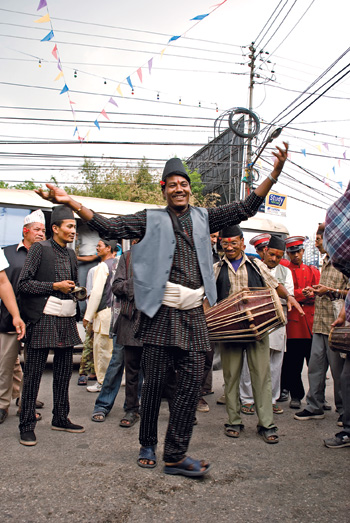 Yet another myth supposes that the Bhramin’s bejewel staff is analogous to a golden scepter that symbolizes the power and the divine sanction of a ruler over his subjects. This interpretation suggests that Goddess Tunaldevi, in an Excalibur-like fashion, extracts the symbolic scepter from the pond to bequeath it to the ruler, ensuring another year of prosperous administration.
Yet another myth supposes that the Bhramin’s bejewel staff is analogous to a golden scepter that symbolizes the power and the divine sanction of a ruler over his subjects. This interpretation suggests that Goddess Tunaldevi, in an Excalibur-like fashion, extracts the symbolic scepter from the pond to bequeath it to the ruler, ensuring another year of prosperous administration.
All three folklores retell interesting facets of the Jatra, without enumerating on a holistic chronology of events. What they do portray, however, is the interesting way that cultures and religions have overlapped each other to create an ambiguous and abstract set of rituals and celebrations. From the Lingo, a hearken back to animistic totem poles, to Tunal Devi of the pre-Hindu Shakti cult to the legends of Bhat Bhateni that are awash with Vaisnav influences, the Handigaun Jatra is a reenactment that touches upon all the various momentous changes that have come and gone in Handigaun over the millennia.
Handigaun, which has been continuously inhabited for over 2,000 years, has seen Kirats, Licchavis, Mallas, Shahs, Ranas and Panchayats come and go. Each has left its mark on the ever-evolving traditions of the town. With every era, Handigaun has simply morphed itself to accommodate the changes. Whether, it will survive the modern road expansions, matchbox houses and more worryingly the present strain of apathy and indifference, is for historians of a future day to enumerate upon.
This month though, descend down to Handigaun to partake in this unique celebration. You never know what jewels of your own you will discover.
4Must-visit Places in Hadigaun
Hadigaun has much more to offer than just the unique festivals. In case you want to come back here for more, here is the list of places you ought to visit:
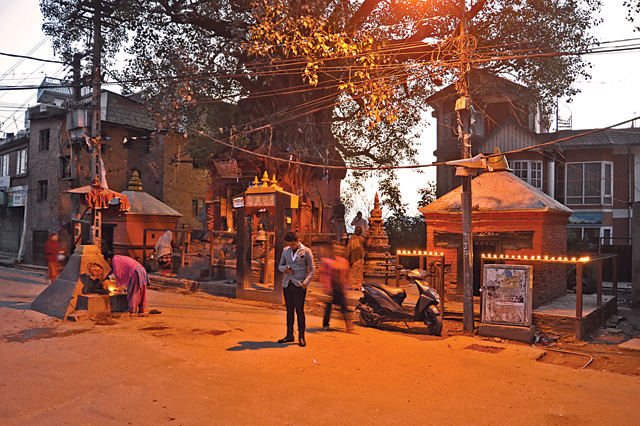 Bhuteshwor Mahadev
Bhuteshwor Mahadev
While the Guheshwori Temple near Pashupati Nath is said to be a part of anus of Sati Devi, Bhuteshwori is said to be a part of a tooth of the same goddess. But that’s not the only attraction of this temple premises. Along with the Krishna Temple which resides inside a Pipal tree, you will also find a damaged idol of Lord Bhairab. According to the legend, the idolmaker died throwing up blood hence his wife damaged it with fury.
Bhat-Bhateni Temple:
In the vicinity of Hadiguan lies a temple of Bhat Bhateni, right in front of its namesake shopping center. If you look inside the temple, you will find its deities hanging in the air. Well, this is because, according to legend, the deities are actually Brahmins who gain the ability to fly with the power of Mani when their child was kidnapped by a rishi.
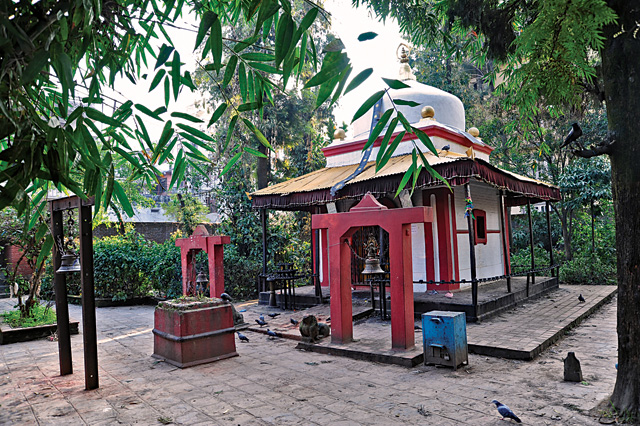
Satya Narayan Temple
This is one of the oldest temples in Hadigaun. Perfect for any season, the best part of the temple’s premises is to get lost and relaxed in the greenery. You can come and read a book or better, read each and every idol here. From stones that have been turned into gods to the idols off 33 koti gods that were torn down during an attack by a Muslim Emperor, you find all of them here. Also, don’t forget to peek into the neighboring area – that is where the jewels of Hadigaun lay, with the ruins of Mangriha, the palace of Lichhavi King Mandev.
Gahana Pokhari
Gahana Pokhari is the main water reservoir of the whole Hadigaun neighborhood. During old times, the pond was filled with water brought from Budhanilkantha through Rajkulo, the royal canal. The legend behind the famous Jatra is related with the pond where the jewelry of one of the three goddesses gets lost. Thus, the jatra focuses on searching the jewelry in the pond.
Eating out Around Hadigaun
When you’re here for the Hadigaun Jatra and get hungry for a bite, there’s no need to travel far – this area is full of great food options, from the quick snack to a more relaxed meal.
The Attic Bar is a great place to retreat from the hustle and bustle of the busy streets. Tucked away behind Tangal Ganeshthan, it’s like stepping into another world. The large mosaic statues give it a unique and artistic feel, and there’s seating both inside and outside—with a large lawn where children can safely play, too. The inner décor is original and unusual, and as the bar doesn’t open till 2, if you come early it’s a great place for lunch amidst an atmosphere of quiet and serenity. The menu includes snacks, lighter lunch options, and heavier dishes as well. I loved their crunchy, oozy Cheese Sticks that came with a pleasantly tangy tartar sauce. The Chicken Teriyaki Salad wasn’t quite what I was expecting, but it was also tasty and generously portioned. There’s a good selection of both hot and cold coffee items too—the Blended Cold Coffee was heavenly on a hot day. I also found the service to be very prompt and the staff friendly and helpful.

The Bhatbhateni branch of the Roadhouse Café is also a great option: I love the décor here, with the stone floors, rustic wooden furniture and the originality and a variety of their lamp shades. The couches along the back wall are wonderfully comfortable and it’s a great place to relax if you’ve been on your feet for a while. There’s a variety of snacks and starters—focaccia, bruschette, salads, and the Humus with Crudites which is what we had to start off with. But let’s not forget what we’re here for: the pizza! I had the Pizza Ala Rucola, and it just hit all the right buttons: a perfect thin crust Italian-style pizza topped with arugula, sun dried tomatoes and parmesan: somehow it managed to taste both fresh and decadent, and I really, really enjoyed it. If you’re still hungry, there’s pasta, wraps, and some delicious-looking grilled items, too. It was great that we didn’t have to wait that long for our food, even though there were quite a few people there. And of course there’s coffee of all sorts to wrap things up with.
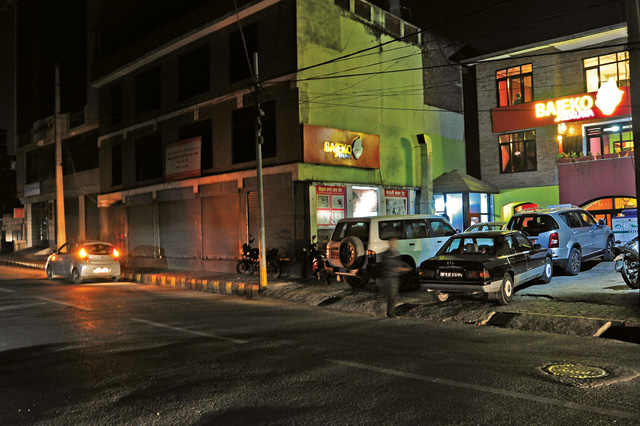
If you’re in the mood for something Nepali, maybe you should head over to Bajeko Sekuwa.
The building is an awesome maze of nooks and crannies, with comfortable seating of all sorts inside and outside, on balconies, up flights of stairs, and in all sorts of unexpected places. Of course there lots of drink options but don’t underestimate the food—I was very impressed with everything we tried. Bandel Tareko was delicious and much more flavourful than I’ve found it at other places, and the Chicken Sekuwa was juicy and tender with just a hint of lime. Aloo Sandeko is always a classic, and it’s well made and generously portioned here. I tried the Jambudeep Haddi Soup for the first time and really loved the rich and unusual flavours. It was unexpected in the best sort of way.
And of course there’s
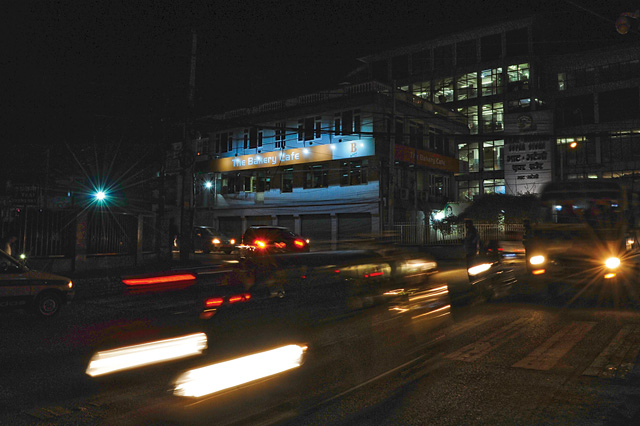 Bhatbhateni Bakery Café, which needs no introduction. When visiting I was impressed by the diverse cross section of people filling up the tables around us and how it never fails to attract people of all kinds here: couples talking quietly, groups of friends enjoying cricket, business people, families eagerly tucking into piles of chips and burgers, pizza and mo:mo. There really is something about this place that appeals to everyone. Of course I had to have the Chicken Mo:mo but my friend went for something different with the Veg Sizzler, and tasting it reminded me that there are many things here that I have yet to try. And whatever your tastes are, it’s certain that here you’ll find something to suit them. With the days getting warmer, the Bakery Café is also offering a special Cool Summer Beverages menu with smoothies, milkshakes and juices of all sorts. The Choco Lady is a fantastic double chocolate blend sure to satisfy the most devoted chocoholic, while the All Nighter is a thick blend of banana and strawberries, packed full of fresh fruit, though I did find it a little on the sweet side.
Bhatbhateni Bakery Café, which needs no introduction. When visiting I was impressed by the diverse cross section of people filling up the tables around us and how it never fails to attract people of all kinds here: couples talking quietly, groups of friends enjoying cricket, business people, families eagerly tucking into piles of chips and burgers, pizza and mo:mo. There really is something about this place that appeals to everyone. Of course I had to have the Chicken Mo:mo but my friend went for something different with the Veg Sizzler, and tasting it reminded me that there are many things here that I have yet to try. And whatever your tastes are, it’s certain that here you’ll find something to suit them. With the days getting warmer, the Bakery Café is also offering a special Cool Summer Beverages menu with smoothies, milkshakes and juices of all sorts. The Choco Lady is a fantastic double chocolate blend sure to satisfy the most devoted chocoholic, while the All Nighter is a thick blend of banana and strawberries, packed full of fresh fruit, though I did find it a little on the sweet side.
These are, of course, only a few of the many restaurants and eateries you can find in Hadigaun, something to get you started as you get out there and explore the many flavours this area has to offer. There’s truly something for everyone!










